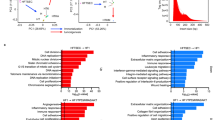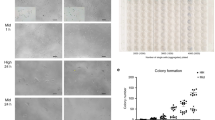Abstract
In embryonic stem (ES) cells, bivalent chromatin domains containing H3K4me3 and H3K27me3 marks silence developmental genes, while keeping them poised for activation following differentiation. We have identified gene sets associated with H3K27me3 and H3K4me3 marks at transcription start sites in a high-grade ovarian serous tumour and examined their association with epigenetic silencing and malignant progression. This revealed novel silenced bivalent marked genes, not described previously for ES cells, which are significantly enriched for the PI3K (P<10−7) and TGF-β signalling pathways (P<10−5). We matched histone marked gene sets to gene expression sets of eight normal fallopian tubes and 499 high-grade serous malignant ovarian samples. This revealed a significant decrease in gene expression for the H3K27me3 and bivalent gene sets in malignant tissue. We then correlated H3K27me3 and bivalent gene sets to gene expression data of ovarian tumour ‘stem cell-like’ sustaining cells versus non-sustaining cells. This showed a significantly lower expression for the H3K27me3 and bivalent gene sets in the tumour-sustaining cells. Similarly, comparison of matched chemo-sensitive and chemo-resistant ovarian cell lines showed a significantly lower expression of H3K27me3/bivalent marked genes in the chemo-resistant compared with the chemo-sensitive cell line. Our analysis supports the hypothesis that bivalent marks are associated with epigenetic silencing in ovarian cancer. However it also suggests that additional tumour specific bivalent marks, to those known in ES cells, are present in tumours and may potentially influence the subsequent development of drug resistance and tumour progression.
This is a preview of subscription content, access via your institution
Access options
Subscribe to this journal
Receive 50 print issues and online access
$259.00 per year
only $5.18 per issue
Buy this article
- Purchase on Springer Link
- Instant access to full article PDF
Prices may be subject to local taxes which are calculated during checkout




Similar content being viewed by others
References
Aletti GD, Gallenberg MM, Cliby WA, Jatoi A, Hartmann LC . Current management strategies for ovarian cancer. Mayo Clin Proc 2007; 82: 751–770.
Berkenblit A, Cannistra SA . Advances in the management of epithelial ovarian cancer. J Reprod Med 2005; 50: 426–438.
Agarwal R, Kaye SB . Ovarian cancer: strategies for overcoming resistance to chemotherapy. Nat Rev Cancer 2003; 3: 502–516.
Bernstein BE, Mikkelsen TS, Xie X, Kamal M, Huebert DJ, Cuff J et al. A bivalent chromatin structure marks key developmental genes in embryonic stem cells. Cell 2006; 125: 315–326.
Ohm JE, McGarvey KM, Yu X, Cheng L, Schuebel KE, Cope L et al. A stem cell-like chromatin pattern may predispose tumor suppressor genes to DNA hypermethylation and heritable silencing. Nat Genet 2007; 39: 237–242.
Widschwendter M, Fiegl H, Egle D, Mueller-Holzner E, Spizzo G, Marth C et al. Epigenetic stem cell signature in cancer. Nat Genet 2007; 39: 157–158.
Ringrose L, Paro R . Epigenetic regulation of cellular memory by the Polycomb and Trithorax group proteins. Annu Rev Genet 2004; 38: 413–443.
Ho JW, Bishop E, Karchenko PV, Negre N, White KP, Park PJ . ChIP-chip versus ChIP-seq: lessons for experimental design and data analysis. BMC Genomics 2011; 12: 134.
Rizzo S, Hersey JM, Mellor P, Dai W, Santos-Silva A, Liber D et al. Ovarian cancer stem cell-like side populations are enriched following chemotherapy and overexpress EZH2. Mol Cancer Ther 2011; 10: 325–335.
Hu L, McArthur C, Jaffe RB . Ovarian cancer stem-like side-population cells are tumourigenic and chemoresistant. Br J Cancer 2010; 102: 1276–1283.
Szotek PP, Pieretti-Vanmarcke R, Masiakos PT, Dinulescu DM, Connolly D, Foster R et al. Ovarian cancer side population defines cells with stem cell-like characteristics and Mullerian Inhibiting Substance responsiveness. PNAS 2006; 103: 11154–11159.
Zhang S, Balch C, Chan MW, Lai HC, Matei D, Schilder JM et al. Identification and characterization of ovarian cancer-initiating cells from primary human tumors. Cancer Res 2008; 68: 4311–4320.
Lee TI, Jenner RG, Boyer LA, Guenther MG, Levine SS, Kumar RM et al. Control of developmental regulators by Polycomb in human embryonic stem cells. Cell 2006; 125: 301–313.
Irizarry RA, Hobbs B, Collin F, Beazer-Barclay YD, Antonellis KJ, Scherf U et al. Exploration, normalization, and summaries of high density oligonucleotide array probe level data. Biostatistics 2003; 4: 249–264.
Cancer Genome Atlas Research Network, Integrated genomic analyses of ovarian carcinoma. Nature 2011; 474: 609–615.
Zhao XD, Han X, Chew JL, Liu J, Chiu KP, Choo A et al. Whole-genome mapping of histone H3 Lys4 and 27 trimethylations reveals distinct genomic compartments in human embryonic stem cells. Cell Stem Cell 2007; 1: 286–298.
Thomas PD, Kejariwal A, Guo N, Mi H, Campbell MJ, Muruganujan A et al. Applications for protein sequence-function evolution data: mRNA/protein expression analysis and coding SNP scoring tools. Nucleic Acids Res 2006; 34: W645–W650.
Schwartz YB, Pirrotta V . Polycomb silencing mechanisms and the management of genomic programmes. Nat Rev Genet 2007; 8: 9–22.
Irizarry RA, Wang C, Zhou Y, Speed TP . Gene set enrichment analysis made simple. Stat Methods Med Res 2009; 18: 565–575.
Tothill RW, Tinker AV, George J, Brown R, Fox SB, Lade S et al. Novel molecular subtypes of serous and endometrioid ovarian cancer linked to clinical outcome. Clin Cancer Res 2008; 14: 5198–5208.
Langdon SP, Lawrie SS, Hay FG, Hawkes MM, McDonald A, Hayward IP et al. Characterization and properties of nine human ovarian adenocarcinoma cell lines. Cancer Res 1988; 48: 6166–6172.
Stronach EA, Alfraidi A, Rama N, Datler C, Studd JB, Agarwal R et al. HDAC4-Regulated STAT1 activation mediates platinum resistance in ovarian cancer. Cancer Res 2011; 71: 4412–4422.
Smyth GK . Linear models and empirical bayes methods for assessing differential expression in microarray experiments. Stat Appl Genet Molec Biol 2004; 3: 3.
Matsumura N, Huang Z, Mori S, Baba T, Fujii S, Konishi I et al. Epigenetic suppression of the TGF-beta pathway revealed by transcriptome profiling in ovarian cancer. Genome Res 2011; 21: 74–82.
Meng Q, Xia C, Fang J, Rojanasakul Y, Jiang BH . Role of PI3K and AKT specific isoforms in ovarian cancer cell migration, invasion and proliferation through the p70S6K1 pathway. Cell Signal 2006; 18: 2262–2271.
Zhang HY, Zhang PN, Sun H . Aberration of the PI3K/AKT/mTOR signaling in epithelial ovarian cancer and its implication in cisplatin-based chemotherapy. Eur J Obstet Gynaecol Reprod Biol 2009; 146: 81–86.
Lu C, Han HD, Mangala LS, Ali-Fehmi R, Newton CS, Ozbun L et al. Regulation of tumor angiogenesis by EZH2. Cancer Cell 2010; 18: 185–197.
Zeller C, Dai W, Steele NL, Siddiq A, Walley AJ, Wilhelm-Benartzi CS et al. Candidate DNA methylation drivers of acquired cisplatin resistance in ovarian cancer identified by methylome and expression profiling. Oncogene 2012; 31: 4567–4576.
Nelson JD, Denisenko O, Bomsztyk K . Protocol for the fast chromatin immunoprecipitation (ChIP) method. Nat Protoc 2006; 1: 179–185.
Langmead B, Trapnell C, Pop M, Salzberg SL . Ultrafast and memory-efficient alignment of short DNA sequences to the human genome. Genome Biol 2009; 10: R25.
Zang C, Schones DE, Zeng C, Cui K, Zhao K, Peng W . A clustering approach for identification of enriched domains from histone modification ChIP-Seq data. Bioinformatics 2009; 25: 1952–1958.
Wu D, Lim E, Vaillant F, Asselin-Labat M-L, Visvader JE, Smyth GK . ROAST: rotation gene set tests for complex microarray experiments. Bioinformatics 2010; 26: 2176–2182.
Acknowledgements
This work was supported by funding from Ovarian Cancer Action; and Cancer Research UK; as well as the Imperial Experimental Cancer Research and Biomedical Research Centres. We are grateful for help from the Gynaecological Oncology team at Hammersmith Hospital and members of the Ovarian Cancer Action Research Centre, in particular Elham Shamsaei, Nona Rama, and Kay Dawson from Dept Pathology. We thank Prof Edison T Liu, Genome Institute of Singapore, and the Agency for Science Technology and Research of Singapore for supporting the microarray expression data on the ovarian tumour and benign samples. Gene expression data generated by The Cancer Genome Atlas (TCGA) Pilot Project established by the NCI and NHGRI were used in the study.
Author information
Authors and Affiliations
Corresponding author
Ethics declarations
Competing interests
The authors declare no conflict of interest.
Additional information
Supplementary Information accompanies the paper on the Oncogene website
Rights and permissions
About this article
Cite this article
Chapman-Rothe, N., Curry, E., Zeller, C. et al. Chromatin H3K27me3/H3K4me3 histone marks define gene sets in high-grade serous ovarian cancer that distinguish malignant, tumour-sustaining and chemo-resistant ovarian tumour cells. Oncogene 32, 4586–4592 (2013). https://doi.org/10.1038/onc.2012.477
Received:
Revised:
Accepted:
Published:
Issue Date:
DOI: https://doi.org/10.1038/onc.2012.477
Keywords
This article is cited by
-
EZH2 mediated metabolic rewiring promotes tumor growth independently of histone methyltransferase activity in ovarian cancer
Molecular Cancer (2023)
-
Detection of metabolic adaptation in a triple-negative breast cancer animal model with [18F]choline-PET imaging as a surrogate for drug resistance
European Journal of Nuclear Medicine and Molecular Imaging (2023)
-
Ubiquitin chromatin remodelling after DNA damage is associated with the expression of key cancer genes and pathways
Cellular and Molecular Life Sciences (2021)
-
Suppression of poised oncogenes by ZMYND8 promotes chemo-sensitization
Cell Death & Disease (2020)
-
Epigenetic therapy for ovarian cancer: promise and progress
Clinical Epigenetics (2019)



